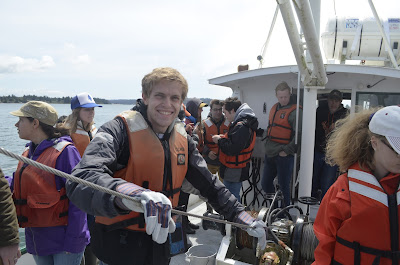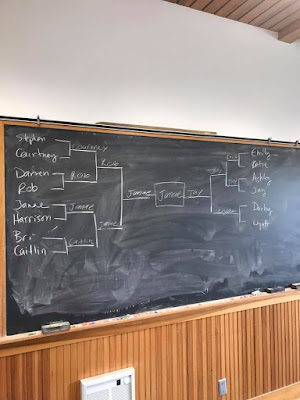Day 21 was full, full, full!
The morning of Day 21 each research team was back at it full steam. Some members were working in the field, others in the lab. I took time to touch base/check up on each group to make sure they were doing all right.
Just before lunch I crossed paths with "Captain Mike". OIMB's chief boat captain. He told me that he could take our group out on the boat to do some bottom and plankton tows. The weather was great. It was windy but sunny! The MBFE crew's spirits were high as we boarded the RV (Research Vessel) Pluteus. Pluteus is the name of sea urchin larvae.
Here's the group before we left the dock.
Here's the whole crew (L-R) Dr. H, Stephen, Wyatt, Katie (front), Janae (behind), Harrison, Courtney, Rob, Darby, Emily, Bri, Jay, Darren, Caitlin, Ashley.
Fifteen passengers set sail that day for a three hour tour, a three hour tour...(sound familiar?)
We had a great outing. It was fun being on the water and the class really enjoyed seeing this aspect of marine biology. We did a couple of bottom dredges and a couple of plankton tows.
Here are a few shots of the crew while we were out.
Students were able to all the deck work while we were out. In this shot Wyatt is running the winch and Courtney was monitoring the dredge during the tow. (L-R) Rob, Bri, Wyatt, Courtney, Darren,
(L-R) Bri, Wyatt, Courtney (foreground), Darren, Ashley, Caitlin and Stephen.
Another shot of the working deck (L-R) Katie, Rob, Darby, Janae, Emily, Bri, Wyatt.
You aren't surprised when a bottom tow produces a haul of sand dollars, but this time it offered up other sea change...looks like a sand quarter, a couple of sand nickels and a sand dime (Emily).
Harrison (foreground) monitors the dredge during another bottom tow. Others are (L-R) Katie, Emily, Janae, Darren, Wyatt, Rob, Captain Mike, and Ashley.
Also on deck are (L-R) Rob, Captain Mike, Ashley, Courtney, Stephen (back) and Bri (front).
It was fun to see what was in the bottom drags. It's like Forrest Gump's mother says, "Life's like a box of chocolates, you never know what you are going to get." (L-R) Stephen, Ashley, Caitlin (fore), Courtney (back), Harrison (on the cable), Jay, Katie, Emily, Rob.
Stephen and Emily look at a sample from the plankton tow.
Though we'd already had a busy day we pulled out the microscopes as soon as we got back to the lab to see what we could see. It was a fantastic sample!
This shot highlights a couple of arrow worms - sharks of the plankton.
This was a real score. I hadn't seen one of these in real life before - it's an Appendicularian. It's a tiny tadpole shaped animal that's actually a distant relative of ours, it's an invertebrate Chordate. It usually lives in a mucous house that it secretes, but it bails out when disturbed. A plankton tow definitely counts as a disturbance!
This is a larval fish. Larval fishes are TINY!
This was a great, though tiring day. Missions accomplished! The students (and I) loved it.



















































